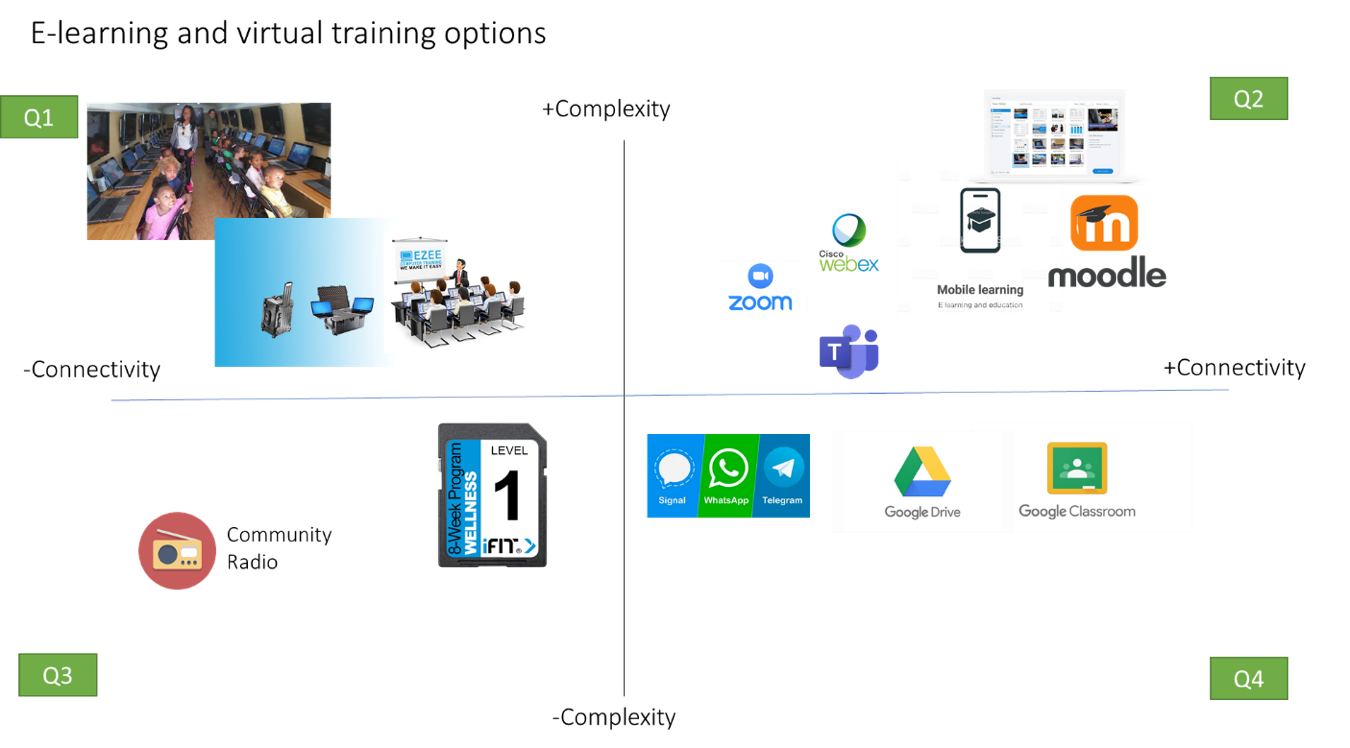Let us know what type of content you'd like to see more of. Fill out our three question survey.
Transforming In-Person Learning into Digital Collaboration
Jul 30, 2020
COVID-19 pushed people into their homes and brought to light the different options that exist to transform the way we learn from in-person settings to online classrooms. Although online learning is not new, the adoption of these learning platforms by the general population has been slow in comparison to the development of new technology-enabled education solutions.
Ginni Rometty, the former CEO of IBM, said that the only way to survive is to continually transform into something different. COVID-19 has forced all of society to transform. International development projects are no different. In recent months, DAI’s Center for Digital Acceleration has received several requests to assist projects in transitioning from what were traditionally online events, workshops, or in-person learning activities to effective virtual experiences. I’ll share here my experience and some considerations for teams going through similar transitions.
Identify Best Tools to Achieve Desired Goal
Is there a difference between e-learning and virtual training? The simple answer is yes. E-learning is complex. It requires production with a diverse group of specialists including instructional designers, content producers, digital designers, system administrators, developers, and experts who, together, produce a lesson that leads students through an incremental knowledge experience.
Virtual training requires a much smaller confluence of expertise. It often requires a practiced facilitator, a well-thought-out presentation, and a format to engage participants. For most international development projects, this is exactly what is required to mimic the in-person training or presentations that were conducted prior to the pandemic. These platforms provide a clear way to present a slide deck and engage in conversation with a select group of people. Understanding these differences is important and requires having a sense of what a project must achieve virtually. In my experience though, I have found that very few projects actually need e-learning to translate their previous in-person work to a virtual setting.
Connectivity and Complexity
International development projects are spread across the globe, which means the digital infrastructure available to them will differ. This is why it is critical to know your user ecosystem, which will help determine their access to digitally connected devices and the reliability of that connection. Understanding this will determine which digital applications, tools, and platforms are best suited for a virtual training or learning experience.
What does this look like in action? In April, DAI held a virtual co-creation workshop for a project in Mexico with 70 participants from around the world. To understand the user’s ecosystem, we ran a quick survey to understand their connectivity. Eighty percent of the respondents had an internet connection via fiber optic or cable. Therefore, we concluded that using a technology platform to host the workshop would not be difficult. For many projects, this is not the reality. Below you can see which tools are available for projects depending on their level of connectivity and the complexity of the training they need to deliver.

Potential use of digital tools for learning and its relationship between user connectivity and production complexity.
In contrast, for a project in Mozambique, I had to adapt virtual training due to low levels of connectivity. To still deliver on the project’s goals, we leveraged community radio and produced high-quality content that engaged listeners. In other words, we learned to use the technology available, rather than try to retrofit the technology we are used to using for virtual events, to effectively engage our target audience.
Technology Works for You—Not the Other Way Around
Many projects see attractive platforms and think they are the best fit for their online learning or virtual training. In reality, the learning curve for these platforms, both for project staff and participants, can be high, diverting energy from important content. It’s important to remember that technology needs to serve the project, not complicate it. Therefore, I recommend clearly defining the objective of your virtual meeting prior to choosing a technology platform. The platform should facilitate that objective. Don’t get distracted with all the fancy software out there.
In product development, omissions of clear research and design of a system or software can lead to failure or creating an unsustainable tool. The same is true for virtual events, except in this case there are really no second chances to replicate the same virtual meeting after learning from your failures.
Other Important Recommendations
-
Define whether the product is temporary or permanent to project success: this is a key factor when defining a technological stack, so you will know whether to buy a license, use the ones you have, or search for something different.
-
Consider the multidimensionality of the resources: audio, video, documents, drawings—depending on your audience—can be leveraged to achieve your objective. But remember, don’t get distracted by flashy new software; trying to teach participants a new system can distract from your intended goal.
-
Integration: there are hundreds of tools out there that can help achieve a good experience; analyze the level of integration of the tools or technologies that are most convenient for you and your project. Again, technology should work for you—not against you.
COVID-19 forced the world to take an unexpected turn. But, keep in mind that this drastic change of circumstances is not a reason to lose sight of the general principles we know to be most effective when engaging people online.